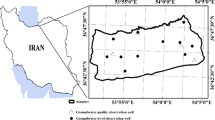Abstract
Though natural attenuation (NA) is increasingly considered as a remediation technology, the methods for proper identification and quantification of NA are still under discussion. Here the ``Virtual Aquifer'' approach is used to demonstrate problems which may arise during measurement of concentrations in observation wells and for interpolation of locally measured concentrations in contaminated heterogeneous aquifers. The misinterpretation of measured concentrations complicates the identification and quantification of natural attenuation processes.
The ``Virtual Aquifer'' approach accepts the plume simulated with a numericalmodel for a heterogeneous aquifer as ``virtual reality''. This virtual plume isinvestigated in the model with conventional methods like observations wells.The results of the investigation can be compared to the virtual ``reality'',evaluating the monitoring method. Locally determined concentrations areinterpolated using various interpolation methods and different monitoringset-ups. The interpolation results are compared to the simulated plume toevaluate the quality of interpolation. This evaluation is not possible in nature,since concentrations in a heterogeneous aquifer are never known in detail.
Similar content being viewed by others
References
Berglund S, Cvetkovic V & Haggerty R (2001) Natural attenuation in heterogeneous aquifers: combined effect of biodegradation and rate-limited mass transfer. Proceedings: Groundwater Quality: Natural and Enhanced Restoration of Groundwater Pollution, 471-478
Bersezio R, Bini A & Guidici M (1999) Effects of sedimentary heterogeneity on groundwater flow in a quarternary proglacial delta environment: joining facies analysis and numerical modelling. Sediment. Geol. 129: 327–344
Boggs MJ, Young SC, Beard LM, Gelhar LW, Rehfeld KR & Adams EE (1992) Field study of dispersion in a heterogeneous aquifer: 1. Overview and site description. Water Resour. Res. 28(12): 3281-3291
Chiang W-H & Kinzelbach W (2000) 3D-Groundwater Modeling with PMWIN: A Simulation System for Modeling Groundwater Flow and Pollution. Springer-Verlag, Berlin, Heidelberg
DVWK (1992) Entnahme und Untersuchungsumfang von Grundwasserproben: DK 556.32.001.5 Grundwasserunter-suchung, DK 543.3.053 Probenahme, pp. 36. Deutscher Verband für Wasserwirtschaft und Kulturbau e.V.
DVWK (1997) Tiefenorientierte Probenahme aus Grundwasser-messstellen, pp. 35. Deutscher Verband für Wasserwirtschaft und Kulturbau e.V.
Flint SS & Bryant ID (1993) Quantitative clastic reservoir geological modelling; problems and perspectives. Proceedings: The gelogical modelling of hydrocarbon reservoirs and outcrop analogues, 3-20
Frenzel H (1995) A Field Generator Based on Meija's Algorithm. Institute for Environmental Physics, University of Heidelberg
Koltermann CE & Gorelick S (1996) Heterogeneity in sedimentary deposits: a review of structure-imitating, process-imitating and descriptive approaches. Water Resour. Res. 32(9): 2617-2658
Martin-Hayden JM & Robbins GA (1997) Plume distortion and apparent attenuation due to concentration averaging in monitoring wells. Ground Water 35(2): 339-346
Monod J (1942) Recherches sur la croissance des cultures bacteriennes. In: Bordet J (Ed) Actualites Scientifiques et Industrielles, Vol 911 (pp 70-78). Hermann et Cie, Paris.
Schäfer D, Schäfer W& Kinzelbach W(1998a) Simulation of reactive processes related to biodegradation in aquifers: 1. Structure of the three-dimensional reactive transport model. J. Cont. Hydr. 31: 167-186
Schäfer D, Schäfer W & Thullner M (1998b) TBC-a novel numerical model for simulation of Transport, Biochemistry and Chemistry in aquifers. Math. Geol. 2: 79-93
Schäfer W (1992) Numerische Modellierung mikrobiell beeinflußter Stofftransportvorgänge im Grundwasser. R. Oldenbourg Verlag, München
Siegenthaler C & Hugenberger P (1993) Pleistocene Rhine gravel: deposits of a braided river system with dominant pool preserva-tion. In: Best J & Bristow C (Eds) Braided Rivers, Vol 75 (pp 47-162). Geological Society Special Publication
Sudicky EA (1986) A natural gradient experiment on solute transport in sand aquifer: spacial variability of hydraulic conductivity and its role in the dispersion process. Water Resour. Res. 22(13): 2069-2082
Vereecken H, Döring U, Hardelauf H, Jaeckel U, Hashagen U, Neuendorf O, Schwarze H & Seidemann R (2000) Analysis of solute transport in a heterogeneous aquifer: the Krauthausen field experiment. J. Cont. Hydr. 45: 329-358
Webb EK & Anderson MP (1996) Simulation of preferential flow in three-dimensional, heterogeneous conductivity fields with realistic internal architecture. Water Resour. Res. 32(3): 533-545
Weissmann GS, Carle SF & Fogg GE (1999) Three dimensional hydrofacies modeling based on soil surveys and transition probability geostatistics. Water Resour. Res. 35(6): 1761-1770
Woodbury AD & Sudicky EA (1991) The geostatistical characteristics of the Borden aquifer. Water Resour. Res. 27(4): 533-546.
Rights and permissions
About this article
Cite this article
Schäfer, D., Schlenz, B. & Dahmke, A. Evaluation of Exploration and Monitoring Methods for Verification of Natural Attenuation Using the Virtual Aquifer Approach. Biodegradation 15, 453–465 (2004). https://doi.org/10.1023/B:BIOD.0000044600.81216.00
Issue Date:
DOI: https://doi.org/10.1023/B:BIOD.0000044600.81216.00




